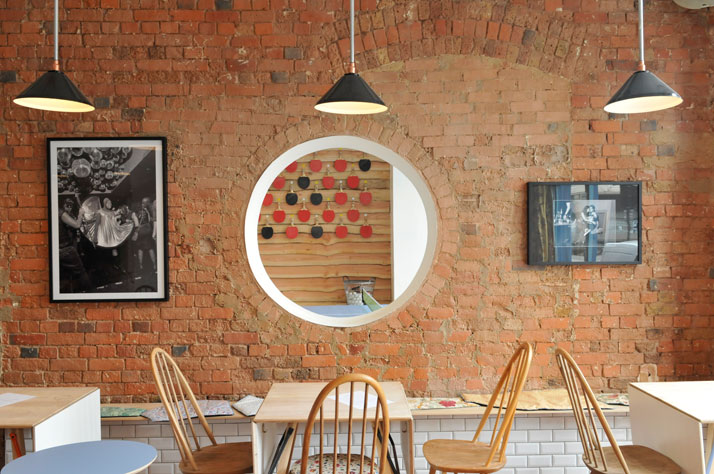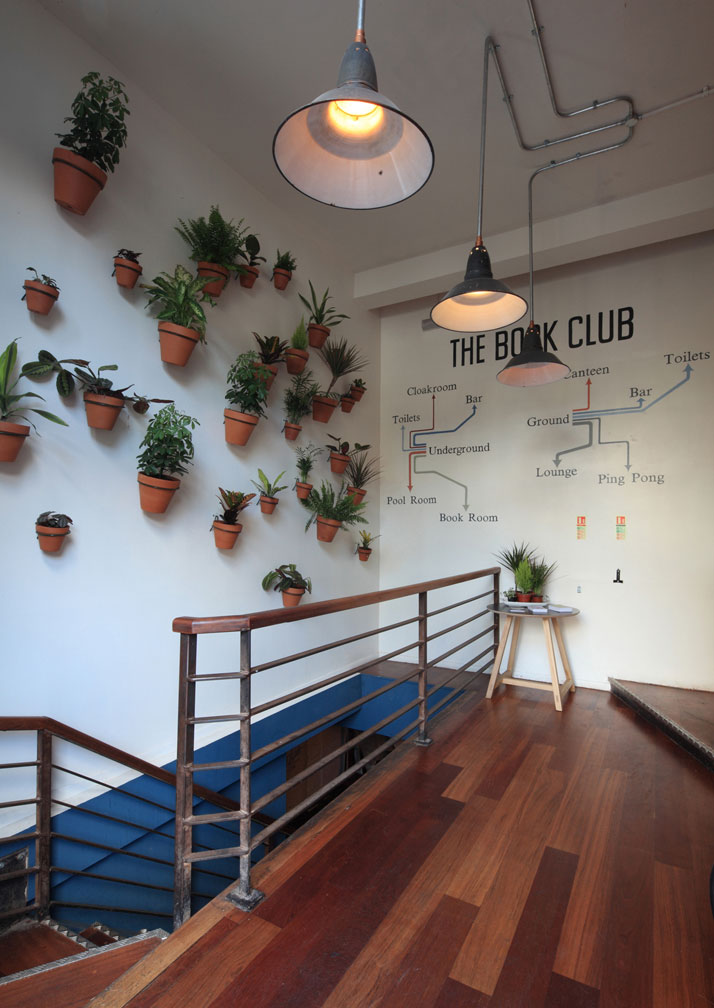The Book Club In The Heart of Shoreditch, East London

photo © Sylvain Deleu
London’s Book Club has it all; bringing together humor, wisdom and offering a cultural revolution to London’s East End social scene. The Book Club (TBC)
is a multi-space which includes an all day bar, club and exhibition
space which operates from the early morning hours to late at night.
Housed in a slightly retouched Victorian warehouse ((100-106 Leonard Street, Shoreditch, London, EC2A 4RH), The Book Club
offers unique interior design spread across two floors – the ground
floor and the underground level. The interior design and creative
direction for the establishment was created by Shai Akram
and inspired by the interiors from New York’s café/bar scene. The
ground floor is comprised of the Canteen, Bar, Ping Pong area, Lounge
and restrooms. The interior design of the ground floor features exposed
full length windows, creating a communication between the street and the
interior, while allowing the space to feel airy, open and naturally
lit. The brick walls of the former Victorian warehouse have been left
untouched and in some cases exposed, while in some cases unique cutout
circles allow customers to see through the width of the interior, thus
creating a sense of communication with other spaces. The electrical
wiring is exposed and vintage-like hanging lamps add to the interior mix
and match character. Mismatched vintage chairs and sofas as well as
long communal tables (the new trend in dining for quite a while now) add
to the shabby-chic feel. Carefully selected vintage and deadstock
fabrics have been selected for the curtains as well as for the cushions
throughout.

photo © Sylvain Deleu

photo © Sylvain Deleu

photo © The Book Club
The Bar has been carefully designed to accommodate the shabby-chic-like mix and match feel of the interior.
Very simple, yet eclectic, the bar stands out from the rest of the
interior due to its all-white and unique black mosaic tiling with hints
of color which also feature The Book Club logo. The Ping-Pong area is
just as impressive as the rest of the interior – word has it that The
Book Club has been London’s hub for ping-pongers for some time now. The
Ping-Pong area, clad in long solid wood planks with the ping-pong
rackets hanging on the wall beckons for a play.
Underneath the ground floor, the
underground level is comprised of areas such as the Book Room, the
Cloak Room, the Pool Room, the Bar and restrooms. As you can probably
muster, the Book Room could not have been missing from The Book Club –a
back room which operates as a private function as well as a screening
room. The underground floor is cozier and undoubtedly has the most
attention grabbing centerpiece on the ceiling above the bar filled with
light bulbs, giving the appearance of a cloud of ping-pong balls
hovering above your head. The underground level continues with the same
laid back and casual shabby-chic interior design approach. A long
communal table pierces through the wall creating an urge to mingle,
while Chesterfield-like sofas and mix and match vintage seating add up
to creating an eclectic feel. The brick walls have been painted in
white so as to brighten up the basement space, while steel beams have
been placed accordingly to support the structure. Moreover, to minimize
the effect of the lower ceiling at the basement level, the ceiling has
been painted in a dark grey achromatic hue which tricks the eye into
believing that the ceiling is taller.

photo © The Book Club

photo © The Book Club

photo © The Book Club
All in all, The Book Club
presents an eclectic ongoing program of events and social activities
in art, music, film, fashion, philosophy, design, science, and the odd
spot of crafts, as well as special screenings and cross platform club
nights showcasing new creative talent. Open seven days a week with an
alternative menu of brain-teasing and mind-expanding thought for food,
it is the younger, slightly smarter sibling of the Queen of Hoxton and
it has turned the conventional arts institution on its head.

